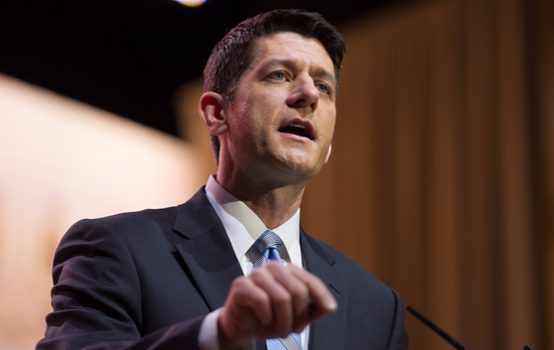Paul Ryan Comes To The End of The Roadmap

Rising from policy wonk to speaker of the House before turning 50, Paul Ryan’s two decades in Washington end—at least for now—with a complicated legacy.
To liberals he is a sinister character from an Ayn Rand novel, a borderline anarcho-capitalist. Tea Party conservatives consider him a statist champion of the establishment while the populist Right regards him as a globalist in league with the Democrats. Like most Republican leaders since Ronald Reagan, he leaves with taxes cut but his budget plans unfulfilled.
The “Roadmap for America’s Future” became the “Path to Prosperity” before reaching its dead end with Donald Trump as president and eventually Democrats in control of the House of Representatives. But before turning the page to the second Nancy Pelosi era, it is worth taking one last look at Ryan’s speakership and what it means for the Republican future.
Although smart, well liked on Capitol Hill, and a strong, telegenic communicator, Ryan hesitated to wield the speaker’s gavel. He saw the job frustrate John Boehner, his immediate predecessor. He was happy chairing Ways and Means or even the House Budget Committee, where his influence over the Republican rank-and-file may have peaked. It was then that another past House speaker, Newt Gingrich, was confronted by an Iowa voter over calling Ryan’s budget blueprint “right-wing social engineering.”
“You’re an embarrassment to our party,” the voter angrily told Gingrich. Not wanting to embarrass the party, Mitt Romney chose Ryan as his running mate when he defeated a field including Gingrich to win the 2012 Republican presidential nomination. The ticket came up short, but Ryan’s stature within the GOP was only enhanced.
If Ryan wasn’t a right-wing social engineer, neither did another Gingrich sobriquet for Republican leaders apply: tax collector for the welfare state. Ryan dedicated his career to right-sizing the American welfare state to fit the country’s typical postwar tax burden without amassing unsustainable debt. He briefly managed to get one house of Congress and most Senate Republicans to go along with him, even when it meant politically risky reforms to Medicare and other popular earned entitlement programs.
This was no small feat. His vision essentially included the federal government doing everything it currently does, with the exception of Obamacare and some of the more direct taxpayer subsidies to businesses unrelated to national defense. This was too much government for the Right and too little for liberals, who in particular questioned whether Ryan would be able to provide adequate benefits under his revamped Medicare.
There was no Goldilocks in this story who found Ryan’s preferred size of government just right. His reputation for fiscal rectitude suffered as the red ink flowed during two periods of unified Republican control in Washington. And Republicans were never completely happy with their one big spending victory under Barack Obama, sequestration, and thus kept cutting deals to partially undo it—at least one of which threatened to erode confidence in the ability to gradually cut spending across Congresses, a central pillar of Ryan’s approach.
A smaller military footprint abroad could have gone a long way toward making the Ryan budgets more politically and mathematically defensible. Yet from Iraq to (most shamefully) Yemen, the Wisconsin Republican marched in lockstep with his party’s most hawkish elements. He was similarly unimaginative about the challenges posed by continuous mass immigration, which along with trade contributed to Republicans in his region of the country drifting from conventional conservatives like Scott Walker and himself to Trump.
Ryan was assailed on all sides over Trump even more than on fiscal policy. He clearly shared the Never Trumpers’ assessment of Trump’s agenda and, at least initially, personal character, though he was obviously impressed by the president’s improbable come-from-behind victory. He wanted more than anything to play Jack Kemp to another Reagan. Instead he got Trump.
Still, Ryan unlike many of his most fervent admirers sought to grapple with the fact that Republican voters chose Trump. From the unsatisfying end to Ryan’s speakership to the closure of The Weekly Standard, conservative leaders must contend with the possibility that aspects of their platform have little purchase with their grassroots supporters—a problem made worse by the absence of an alternative program and the failure to produce any obvious successor to Trump.
Social Security and Medicare reform were probably best pursued while the baby boomers were in their peak earning years. Now they are entering retirement and remain as important a Republican constituency as beneficiaries of other government programs are for Democrats. Paying for their promised benefits without stifling economic growth or amassing onerous debt becomes ever more challenging, even as Democrats increasingly favor expanding those benefits to more voters still.
On some of these questions, Ryan may have represented the right side of the possible. Whether he mounts a comeback or not, some Republican leader will need to find a way to navigate past the end of the Roadmap.
W. James Antle III is editor of The American Conservative.
Comments